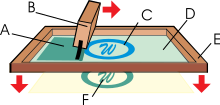Screen Printing

Trolley containing a wooden squeegee and acrylic ink
Screen printing is also a stencil method of print making in which a design is imposed on a screen of polyester or other fine mesh, with blank areas coated with an impermeable substance.Ink is forced into the mesh openings by the fill blade or squeegee and by wetting the substrate, transferred onto the printing surface during the squeegee stroke. As the screen rebounds away from the substrate the ink remains on the substrate. It is also known as silk-screen, screen, serigraphy, and serigraph printing.One color is printed at a time, so several screens can be used to produce a multicoloured image or design.
Steps
1. Designing the model.The 2D design of the model was developed using CutStudio.
2. Cutting using Vinyl cutter and Pasting, after creating holes, the stencil is pasted on to the screen.
3. Wiping Process.

A. Ink. B. Squeegee. C. Image. D. Photo-emulsion. E. Screen. F. Printed image.

How to screen print one image

How to screen print with multiple layers



